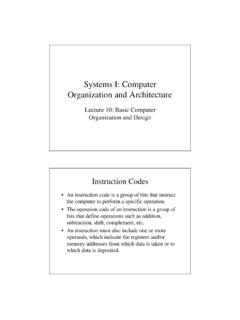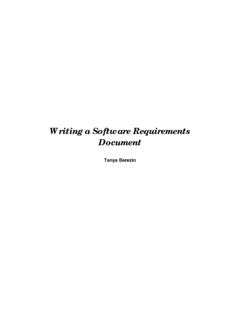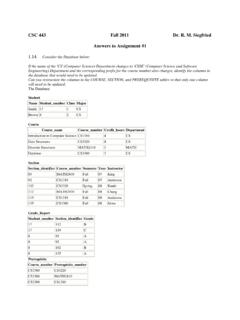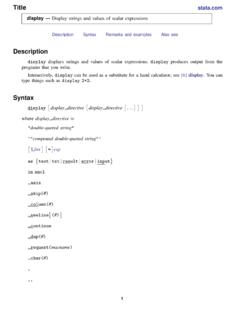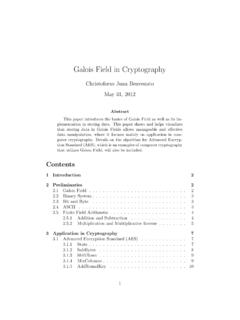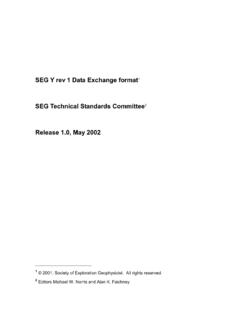Transcription of Data Representation
1 1 CSC 170 Introduction to Computers and Their ApplicationsLecture #1 Digital BasicsData Representation Datarefers to the symbols that represent people, events, things, and ideas. Data can be a name, a number, the colors in a photograph, or the notes in a musical composition. Data Representationrefers to the form in which data is stored, processed, and transmitted. Devices such as smartphones, iPods, and computers store data in digital formats that can be handled by electronic Representation Digitizationis the process of converting information, such as text, numbers, photo, or music, into digital data that can be manipulated by electronic devices.
2 The Digital Revolution has evolved through four phases, beginning with big, expensive, standalone computers, and progressing to today s digital world in which small, inexpensive digital devices are Representation The 0s and 1s used to represent digital data are referred to as binary digits from this term we get the word bitthat stands for binary digit. A bit is a 0 or 1 used in the digital Representation of data. A digital file, usually referred to simply as a file, is a named collection of data that exits on a storage medium, such as a hard disk, CD, DVD, or flash RepresentationRepresenting Numbers Numeric dataconsists of numbers that can be used in arithmetic operations.
3 Digital devices represent numeric data using the binary number system, also called base 2. The binary number systemonly has two digits: 0 and 1. No numeral like 2 exists in the system, so the number two is represented in binary as 10 (pronounced one zero ).4 Representing NumbersDECIMAL (BASE 10)BINARY (BASE 2)00112103114100510161107111810009100110 101011101110001111101000 Representing Text Character data is composed of letters, symbols, and numerals that are not used in calculations. Examples of character data include your name, address, and hair color. Character data is commonly referred to as text.
4 5 Representing Text Digital devices employ several types of codes to represent character data, including ascii , Unicode, and their variants. ascii (American Standard Code for Information Interchange, pronounced ASK ee ) requires seven bits for each character. The ascii code for an uppercase Ais Text extended ascii is a superset of ascii that uses eight bits for each character. For example, extended ascii represents the uppercase letter Aas 01000001. Using eight bits instead of seven bits allows extended ascii to provide codes for Text Unicode(pronounced YOU ni code ) uses sixteen bits and provides codes or 65,000 characters.
5 This is a bonus for representing the alphabets of multiple languages. UTF-8 is a variable-length coding scheme that uses seven bits for common ascii characters but uses sixteen-bit Unicode as Text00100000 Space 00110011301000110F 01011001Y 01101100l 00100001! 00110100401000111G 01011010Z 01101101m 00100010"00110101501001000H 01011011[ 01101110n 00100011# 00110110601001001I 01011100\01101111o 00100100$ 00110111701001010J 01011101] 01110000p 00100101% 00111000801001011K 01011110^ 01110001q 00100110& 00111001901001100L 01011111_ 01110010r 00100111' 00111010: 01001101M 01100000` 01110011s 00101000( 00111011; 01001110N 01100001a 01110100t 00101001) 00111100< 01001111O 01100010b 01110101u 00101010* 00111101= 01010000P 01100011c 01110110v 00101011+ 00111110> 01010001Q 01100100d 01110111w 00101100, 00111111?
6 01010010R 01100101e 01111000x 00101101-01000000@ 01010011S 01100110f 01111001y 00101110. 01000001A 01010100T 01100111g 01111010z 00101111/ 01000010B 01010101U 01101000h 01111011{ 00110000001000011C 01010110V 01101001i 01111100| 00110001101000100D 01010111W 01101010j 01111101} 00110010201000101E 01011000X 01101011k 01111110~ 7 Representing Text ascii codes are used for numerals, such as Social Security numbers and phone numbers. Plain, unformatted text is sometimes called ascii text and is stored in a so-called text file with a name ending in .txt. On Apple devices these files are labeled Plain Text.
7 In Windows, these files are labeled Text Document .Representing Text ascii text files contain no formatting. To create documents with styles and formats, formatting codes have to be embedded in the Text Microsoft Word produces formatted text and creates documents in DOCX format. Apple Pages produces documents in PAGES format. Adobe Acrobat produces documents in PDFformat. HTML markup language used for Web pages produces documents in Text9 Bites and Bytes All of the data stored and transmitted by digital devices is encoded as bits. Terminology related to bits and bytes is extensively used to describe storage capacity and network access speed.
8 The word bit, an abbreviation for binary digit, can be further abbreviated as a lowercase b. A group of eight bits is called a byteand is usually abbreviated as an uppercase and Bytes When reading about digital devices, you ll frequently encounter references such as 90 kilobits per second, megabytes, gigahertz, and 2 terabytes. Kilo, mega, giga, tera, and similar terms are used to quantify digital and BytesBitOne binary digitByte8 bitsKilobit1,024 or 210bitsKilobyte1,024 or 210bytesMegabit1,048,576 or 220bitsMegabyte1,048,576 or 220bytesGigabit230 bitsGigabyte230bytesTerabyte240bytesPeta byte250bytesExabyte260bytesBites and Bytes Use bits for data rates, such as Internet connection speeds, and movie download speeds.
9 Use bytes for file sizes and storage capacities. 104 KB: Kilobyte (KB or Kbyte) is often used when referring to the size of small computer and Bytes 56 Kbps: Kilobit (Kb or Kbit) can be used for slow data rates, such as a 56 Kbps (kilobits per second) dial-up connection. 50 Mbps: Megabit (Mb or Mbit) is used for faster data rates, such as a 50 Mbps (megabits per second) Internet and Bytes MB: Megabyte (MB or MByte) is typically used when referring to the size of files containing photos and videos. 100 Gbit: Gigabit (Gb or Gbit) is used for really fast network speeds. 16 GB: Gigabyte (GB or GByte) is commonly used to refer to storage capacity12 Data Compression To reduce file size and transmission times, digital data can be compressed.
10 Data compressionrefers to any technique that recodes the data in a file so that it contains fewer bits. Compression is commonly referred to as zipping. Data Compression Compression techniques divided into two categories: losslessand lossy Lossless compression provides a way to compress data and reconstitute it into its original state; uncompressed data stays exactly the same as the original data Lossy compression throws away some of the original data during the compression process; uncompressed data is notexactly the same as the original13 Data Compression Software for compressing data is sometimes referred to as a compression utility or a zip tool.

